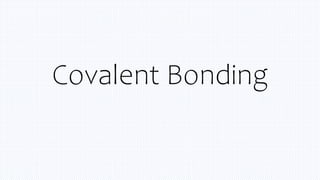presentation covalent bonding.pptx
•Download as PPTX, PDF•
0 likes•11 views
a presentation on covalent bonding
Report
Share
Report
Share

Recommended
Recommended
More Related Content
Similar to presentation covalent bonding.pptx
Similar to presentation covalent bonding.pptx (20)
Explain covalent bond- Explain Metallic bond and what important proper.docx

Explain covalent bond- Explain Metallic bond and what important proper.docx
Valence bond theory VBT (Full explanation) # Inorganic Chemistry #Chemistry D...

Valence bond theory VBT (Full explanation) # Inorganic Chemistry #Chemistry D...
There are two types of atomic bonds - ionic bonds and covalent bonds.pdf

There are two types of atomic bonds - ionic bonds and covalent bonds.pdf
Class 11 Chemistry Revision Notes Chemical Bonding and Molecular Structure.pdf

Class 11 Chemistry Revision Notes Chemical Bonding and Molecular Structure.pdf
johnvic098 chemical bonds inoin bond covalent bond metallic bond.pptx

johnvic098 chemical bonds inoin bond covalent bond metallic bond.pptx
Recently uploaded
Bioenergetics is an important domain in biology. This presentation has explored ATP production and its optimum utilization in biological systems along with certain theories and experiments to give a bird's eye view of this important issue.Energy is the beat of life irrespective of the domains. ATP- the energy curre...

Energy is the beat of life irrespective of the domains. ATP- the energy curre...Nistarini College, Purulia (W.B) India
Recently uploaded (20)
POGONATUM : morphology, anatomy, reproduction etc.

POGONATUM : morphology, anatomy, reproduction etc.
LUNULARIA -features, morphology, anatomy ,reproduction etc.

LUNULARIA -features, morphology, anatomy ,reproduction etc.
Role of AI in seed science Predictive modelling and Beyond.pptx

Role of AI in seed science Predictive modelling and Beyond.pptx
FAIRSpectra - Enabling the FAIRification of Analytical Science

FAIRSpectra - Enabling the FAIRification of Analytical Science
Porella : features, morphology, anatomy, reproduction etc.

Porella : features, morphology, anatomy, reproduction etc.
COMPOSTING : types of compost, merits and demerits

COMPOSTING : types of compost, merits and demerits
Cot curve, melting temperature, unique and repetitive DNA

Cot curve, melting temperature, unique and repetitive DNA
Use of mutants in understanding seedling development.pptx

Use of mutants in understanding seedling development.pptx
Efficient spin-up of Earth System Models usingsequence acceleration

Efficient spin-up of Earth System Models usingsequence acceleration
FAIRSpectra - Enabling the FAIRification of Spectroscopy and Spectrometry

FAIRSpectra - Enabling the FAIRification of Spectroscopy and Spectrometry
GBSN - Biochemistry (Unit 2) Basic concept of organic chemistry 

GBSN - Biochemistry (Unit 2) Basic concept of organic chemistry
Energy is the beat of life irrespective of the domains. ATP- the energy curre...

Energy is the beat of life irrespective of the domains. ATP- the energy curre...
Thyroid Physiology_Dr.E. Muralinath_ Associate Professor

Thyroid Physiology_Dr.E. Muralinath_ Associate Professor
presentation covalent bonding.pptx
- 3. Formation of Covalent Bond A covalent bond forms when the difference between the electronegativities of two atoms is too small for an electron transfer to occur to form ions. Shared electrons located in the space between the two nuclei are called bonding electrons. The bonded pair is the “glue” that holds the atoms together in molecular units. The idea that two electrons can be shared between two atoms and serve as the link between them was first introduced in 1916 by the American chemist G.N. Lewis, who described the formation of such bonds as resulting from the tendencies of certain atoms to combine with one another in order for both to have the electronic structure of a corresponding noble-gas atom. Covalent bonds are directional, meaning that atoms so bonded prefer specific orientations relative to one another; this in turn gives molecules definite shapes, as in the angular (bent) structure of the H2O molecule. Covalent bonds between identical atoms (as in H2) are nonpolar—i.e., electrically uniform—while those between unlike atoms are polar—i.e., one atom is slightly negatively charged and the other is slightly positively charged. This partial ionic character of covalent bonds increases with the difference in the electronegativities of the two atoms.
- 4. Types of Covalent Bonds Molecules that have covalent linkages include the inorganic substances hydrogen, nitrogen, chlorine, water, and ammonia (H2, N2, Cl2, H2O, NH3) together with all organic compounds. In structural representations of molecules, covalent bonds are indicated by solid lines connecting pairs of atoms; e.g.,